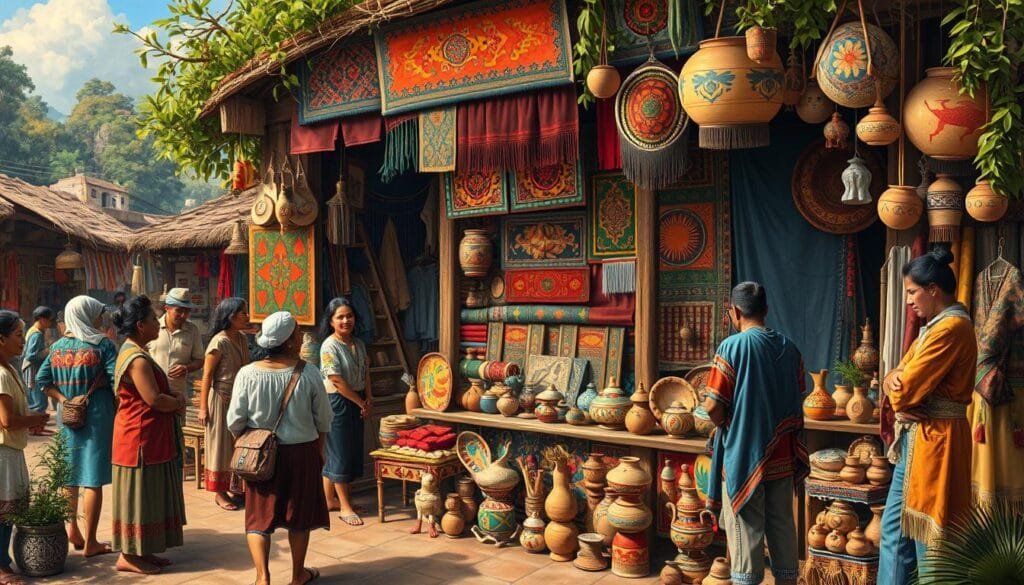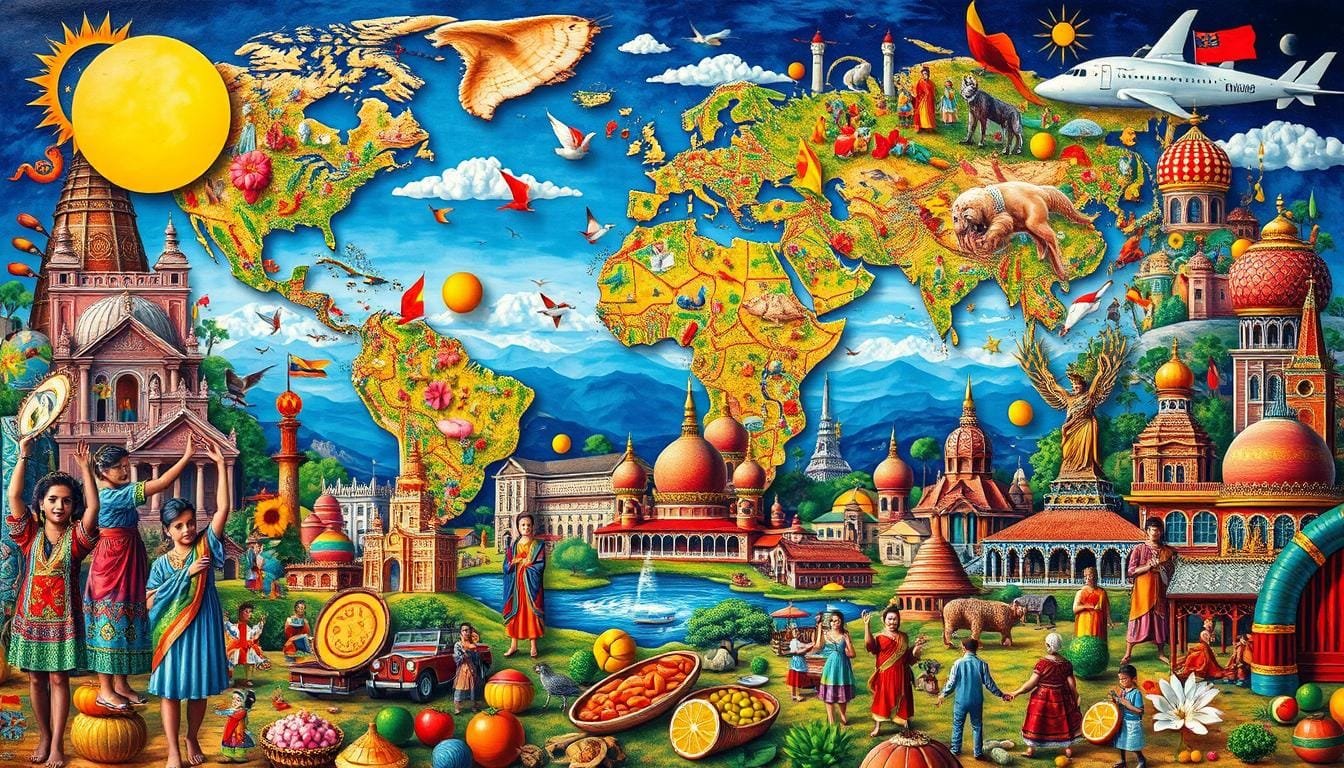Ever wonder why it’s important to understand cultural differences? In today’s world, knowing about cultural norms is key. It helps us interact respectfully and effectively across the globe. This is true whether we’re traveling, working internationally, or in multicultural settings.
Our guide sheds light on respecting different cultures. Learn about the Sami people’s reindeer herding or the Black Hmong’s rice farming. We’ll show you why it’s crucial to acknowledge cultural diversity. Our tips and strategies will help you learn and adapt to new customs and traditions smoothly.
Key Takeaways
- Understanding cultural differences is crucial for respectful and effective global interactions.
- Our guide provides insights into diverse practices, such as Sami reindeer herding and Black Hmong terraced rice farming.
- Researching cultural norms beforehand helps in respectful engagement and adaptation.
- Key methods to learn about cultural norms include consulting local experts and observing traditions.
- Practical tips for travelers on respecting local customs, including language greetings and gratitude expressions.
Understanding Cultural Norms: An Introduction
Cultural norms act as the backbone of how societies interact and stick together. They shape our daily lives and how we connect with others. For example, in the U.S., personal space is mostly between 18 inches to 4 feet. But norms differ globally, affecting everything from personal space to marriage customs.
Looking at grocery shopping shows us how cultural differences are clear. About 80% of Americans do their grocery shopping weekly. They buy everything they need for a week. However, in Paris, people often go to outdoor markets daily for fresh food. Family living situations also differ. In Asia, it’s common for many generations to live under one roof. Yet, in Canada, people usually live on their own before starting a family.
Marriage customs also show cultural differences. In the U.S., love often drives over 50% of marriages. But in places like India and Nigeria, many marriages are arranged. This shows how values and traditions vary. Also, North Americans tend to keep a personal bubble in social interactions. Close physical proximity is more accepted in Middle Eastern cultures, highlighting more differences.
George Murdock’s study on cultural universals, like humor and family systems, shows we share some experiences. Humor, for instance, is key in 95% of interactions around the world. It helps people from diverse backgrounds connect and understand each other better.
Cultural lag helps explain changes in society. It tells us how our material culture, like tech, can quickly change. But our non-material culture, which includes beliefs and values, changes more slowly. Sometimes, this slow change causes friction in society.
Understanding cultural norms means recognizing both shared and different traits across societies. Appreciating these aspects helps us deeply explore specific norms and their importance. We will look more into these norms and their roles in further sections.
What Are Cultural Norms?
Cultural norms are shared expectations that guide how people in groups act. They keep society orderly and predictable. Cultural norms are key in building societies. They bring people together, creating a shared sense of understanding.
Definition and Importance
Cultural norms are the unwritten rules about how to behave. They set what behavior is ok. By making clear what is expected, cultural norms help people live together smoothly. They keep social peace and stop chaos. This keeps society healthy and strong.
For example, diverse and fair workplaces are becoming a new norm. Strong leadership and clear norms lead to 70% employee engagement and happiness. Also, companies with clear norms see 30% less staff leaving. This shows how cultural norms help keep good workers.
Changes in work culture are also vital. After the pandemic, 61% of workers now prefer to work from home. Having shorter meetings can make teams 20% more productive. And avoiding too much control can boost performance by up to 25%. These changes highlight the need for new norms at work.

Examples from Around the World
Different places have their own cultural norms. In Japan, people bow to show respect. In Western countries, a firm handshake is the norm. These examples show how cultural practices vary worldwide.
In Scandinavia, being professional at work makes customers 15% more satisfied. Inclusive and respectful workplaces can improve team performance by 35%. And places that value diversity see a 25% increase in employee engagement. These facts highlight how cultural norms impact behavior and success globally.
Cultural norms change over time as society changes. Staying up-to-date with these shifts is key for people and businesses. Keeping up ensures we respect and work well in different cultures. Therefore, the role of cultural norms is fundamental in shaping society and businesses. They show a balance between tradition and innovation.
How to Research and Learn About Cultural Norms
Learning about cultural norms is key in our diverse world. It’s important to work with local experts and watch closely to understand better. Developing good methods for cultural research helps us understand more and build meaningful relationships.
Asking Local Experts
One great way to learn about cultures is to talk with local experts. They know a lot about their culture’s ways and traditions. Talking to them gives us direct insights and helps us understand complex cultural details.
These experts can also introduce us to more resources in the community.
- Community organizations
- Educational institutions
- Social groups
Reading and Observing
Reading and watching closely also helps us understand cultures. Reading about cultural history and traditions teaches us a lot. Watching without judging lets us see how people behave in context.
Good ways to observe include:
- Going to local events
- Taking part in community activities
- Visiting different cultural settings
Research shows that understanding and respecting cultures improves engagement and work. Many misunderstandings come from not knowing. But doing good research on cultural norms helps reduce those gaps.
| Method | Advantages | Challenges |
|---|---|---|
| Engaging Local Experts | Accurate, firsthand insights | Finding experts |
| Reading and Observing | Comprehensive understanding | Time-consuming |
Basically, using different methods like talking to local experts and immersing in reading and observation helps us really understand cultural norms. This not only helps us grow but also makes society more connected and understanding.
Practical Tips for Respecting Cultural Norms While Traveling
When we travel, respecting cultural norms boosts our experience and creates positive connections. Being prepared helps us engage with different cultures respectfully. Here are some cultural travel tips for a meaningful journey.
Researching in Advance
Before you go, research the local culture and what’s expected. About 58% of travelers study up beforehand, using guidebooks and websites. This helps avoid actions that could be seen as offensive.
Without research, 55% of travelers might disrespect local norms by mistake. Knowing things like dress codes is crucial, especially in religious sites where 60% think modesty matters.
Greet and Express Gratitude in the Local Language
Knowing a few phrases in the local language is a sign of respect and improves interactions. Surveys show 90% of locals like it when tourists try to speak their language. Even simple greetings make a big difference in communication and cultural exchange.
Also, 72% of hosts feel better about travelers who greet them in their language. This effort shows respect and leads to more enriching cultural experiences.

A thoughtful approach towards other cultures can make our travels more enriching. Getting involved in local traditions, like festivals, connects us deeper to the culture. This is something 69% of tourists feel after participating, thanks to these cultural travel tips.
Let’s look at how research and language learning before a trip impact cultural respect:
| Aspect | Statistic | Positive Impact |
|---|---|---|
| Pre-trip Research | 58% | Avoids cultural misunderstandings |
| Learning Local Phrases | 90% | Enhances communication and cultural exchange |
| Greeting Hosts in Native Language | 72% | Improves local interactions |
| Participating in Local Traditions | 69% | Deepens cultural understanding |
Engaging with Indigenous and Nomadic Cultures
Exploring indigenous cultures and nomadic traditions opens our eyes to the world’s diversity. These unique ways of life, rooted in tradition and community, help bridge gaps between cultures. This fosters respect and helps preserve different identities.

Respecting Local Traditions
The Indian Removal Act between 1830 and 1838 forced nearly 100,000 Indigenous people to move. They went from the southern states to what is now Oklahoma. This act shows a dark part of history.
Indigenous peoples of the Plains changed their lives in the 18th century, becoming nomads with the introduction of horses by the Spanish. This change shows their ability to adapt and survive. They maintain a deep respect for their traditions, passing down ancient wisdom. Yet, they face many challenges today.
Traditional knowledge is key to the identity and survival of indigenous cultures. It’s passed down through generations. The United Nations talks about how this knowledge helps with education and fighting climate change. There’s a myth that these practices harm the environment. But, they are actually essential for taking care of our planet.
Volunteering Opportunities
Volunteering is a great way to dive into indigenous and nomadic cultures. In Namibia, the constitution recognizes many languages. But, three groups still need better access to their native language education. Volunteers can help fill this gap, preserving important languages.
In Belarus, education happens in 25 different languages. This helps save languages from disappearing. Finland is following this example, with programs teaching in the Sami language. These efforts show how combining education in native and community languages is beneficial for all.
Language, land rights, and education are keys to empowering indigenous women, who face more discrimination. Cultural volunteering supports both financial and technical needs for preserving their traditions. It ensures their heritage and identity continue to thrive for future generations.
Common Pitfalls to Avoid When Navigating Cultural Norms
Understanding cultural sensitivities helps us respect and interact well across cultures. However, it’s easy to make mistakes due to not knowing different social norms and rules. For example, since 70% of our communication is non-verbal, knowing body language is key to avoid offending others.
To avoid cultural mistakes, let’s look at some common issues and solutions:
Stereotypes and prejudices are big barriers in cultural sensitivity. They cause misunderstandings, affecting teamwork. In business, 65% of workers say cultural differences have led to misunderstandings in meetings.
Adjusting how we talk is a big challenge. 70% of team leaders say it’s crucial for better work in international teams. Also, 80% of people change their speaking style to match the cultural background of their audience. This shows how important flexibility is.
Basing judgments of other cultures solely on your own culture causes 50% of international partnerships to fail. It’s key to avoid such thinking to understand cultural differences better and improve communication.
International students face cultural challenges too. About 70% get culture shock, and 75% slip up culturally in the first six months. Getting to know the local culture early on and using university support can help. Such steps lower cultural misunderstandings by up to 40%. Yet, only 30% of students make full use of these resources before starting their studies.
To steer clear of cultural mishaps, it helps to know these facts:
| Statistic | Implication |
|---|---|
| 70% of communication occurs through non-verbal cues | Emphasizes the importance of understanding body language |
| 75% of organizations face challenges related to stereotypes | Affects teamwork and effective collaboration |
| 50% of international partnerships fail due to ethnocentrism | Stresses the need for cultural understanding and empathy |
| 80% of individuals adjust their communication style | Highlights adaptability’s role in avoiding cultural offenses |
| Proactive use of cultural resources reduces misunderstandings by up to 40% | Shows the benefit of engaging with local cultures and resources |
By knowing about these pitfalls and working to avoid them, we can have better cultural interactions. Learning more and adapting our communication helps us understand cultural norms better.
Enhancing Cross-Cultural Communication
Our world is getting more connected, making good cross-cultural communication essential. Many teams now include people from different cultures. It’s important to understand non-verbal signals and listen well. This helps everyone get along better.
Understanding Non-Verbal Cues
Non-verbal cues are key in talking across cultures. Knowing and understanding these signals can close cultural gaps. For example, eye contact is good in the West, but not always in Asia. Knowing this helps avoid misunderstandings.
Cultural mistakes can hurt team unity. About 70% of cross-cultural teams face challenges due to cultural insensitivity. Being aware of cultural differences reduces conflict. This makes for a better team environment.
Cultures differ in how close they stand or how they greet each other. For instance, handshakes are common in the US, while bows are preferred in Japan. Adapting to these practices can improve communication.
Effective Listening
Listening well is crucial for talking across cultures. Active listening means fully focusing and responding well. This makes people feel respected and improves team trust.
Many non-native English speakers find idioms confusing. Using simple language helps. It can make understanding 90% better for them. This way, everyone feels part of the conversation.
Asking open-ended questions improves conversation by 40%. It allows for deeper talks. People can share more openly, which improves communication.
Valuing cultural differences helps workplaces a lot. It boosts productivity and happiness at work. By understanding non-verbal cues and listening well, we make our workplaces more welcoming.
Conclusion
As we wrap up our look at cultural norms, it’s clear how crucial they are. They help us connect across different cultures. We’ve covered cultural competence and humility, vital for effective communication. Knowing our culture and understanding others’ can improve how we interact and experience the world.
Cultural humility was introduced by Melanie Tervalon and Jann Murray-Garcia in 1998. It tells us learning about culture never stops. It’s not about being perfect but about improving ourselves and our connections. This mindset helps us avoid misunderstandings in diverse settings.
Keeping an open mind and being curious helps us welcome many views. This makes our lives richer and helps us support a welcoming world. For more insights on cultural diplomacy, check out this resource. Being mindful of cultural norms and showing respect daily can lead to a harmonious world. It’s about making cultural diversity part of our nature.
FAQ
What are cultural norms?
Cultural norms are the rules that guide how we act in society. They help everyone get along and understand each other. This makes communities run smoothly.
Why is it important to understand cultural norms?
Knowing cultural norms is key to getting along with people from different places. It prevents misunderstandings and helps include everyone. We build stronger bonds and communities by respecting these differences.
Can you provide examples of cultural norms from around the world?
Sure. In Japan, people bow to say hello, showing respect. Hospitality is very important in Middle Eastern countries. And in India, touching the feet of elders is a way to show deep respect.
How can I research and learn about cultural norms before traveling?
Talk to people who know the culture well, and read up on it. Watch how people in that community interact. Community groups and websites on cultural learning are great resources too.
What are some practical tips for respecting cultural norms while traveling?
Do your homework before you go. Learning some local words and phrases is a good start. Being prepared shows you care and can make your visit more enjoyable.
How can I respectfully engage with indigenous and nomadic cultures?
Be genuinely interested in their traditions. Volunteering helps you connect and give back at the same time. There are groups worldwide that can set you up with such opportunities.
What are some common mistakes to avoid when navigating cultural norms?
Don’t think your way is the only way. Start by listening and keeping an open mind. Avoid being judgmental or arrogant to learn and adapt better.
How can I enhance my communication across different cultures?
Pay close attention to non-verbal signals, as they change from one culture to another. Also, listen carefully. Understanding body language and expressions can help you catch the unspoken parts of a conversation.
